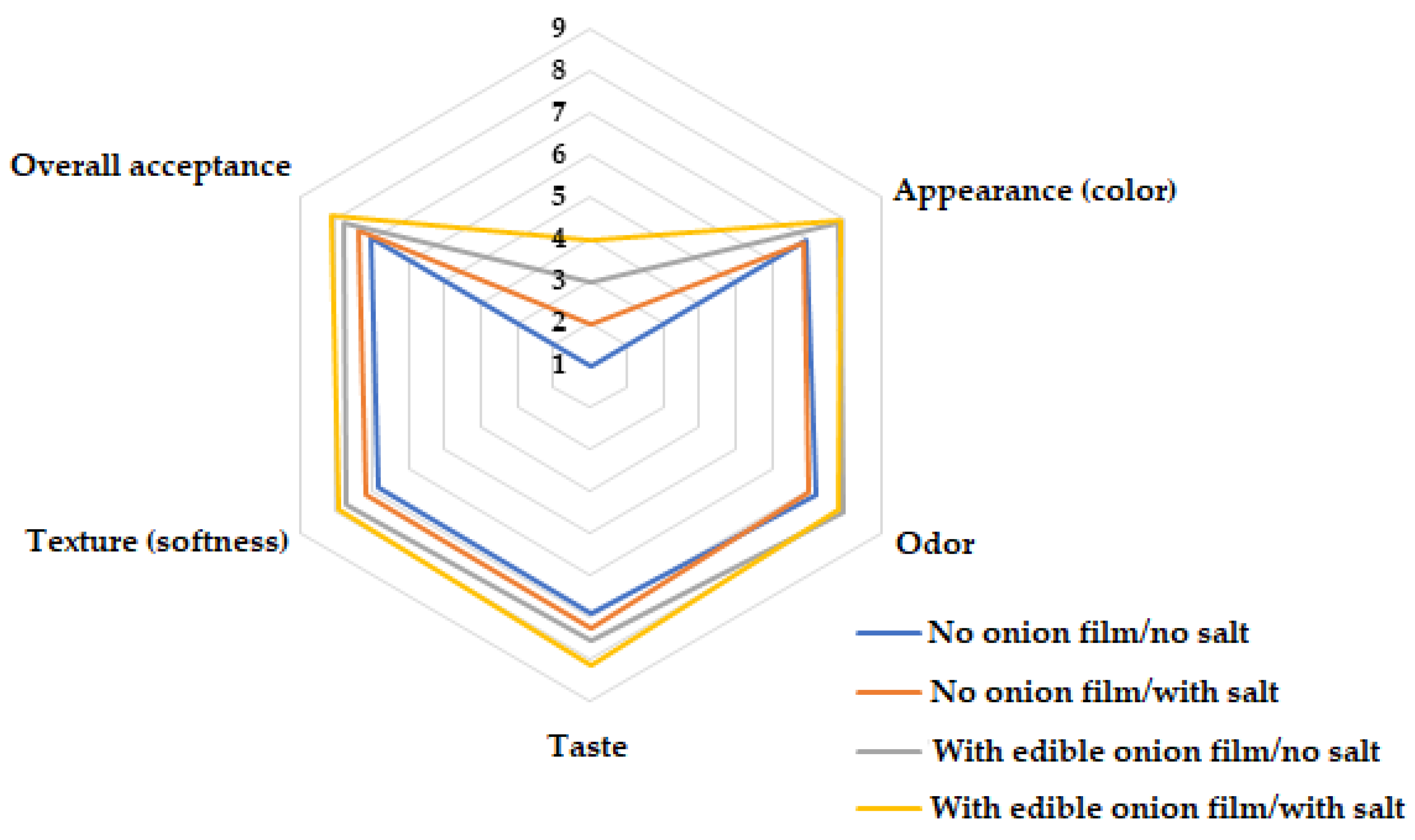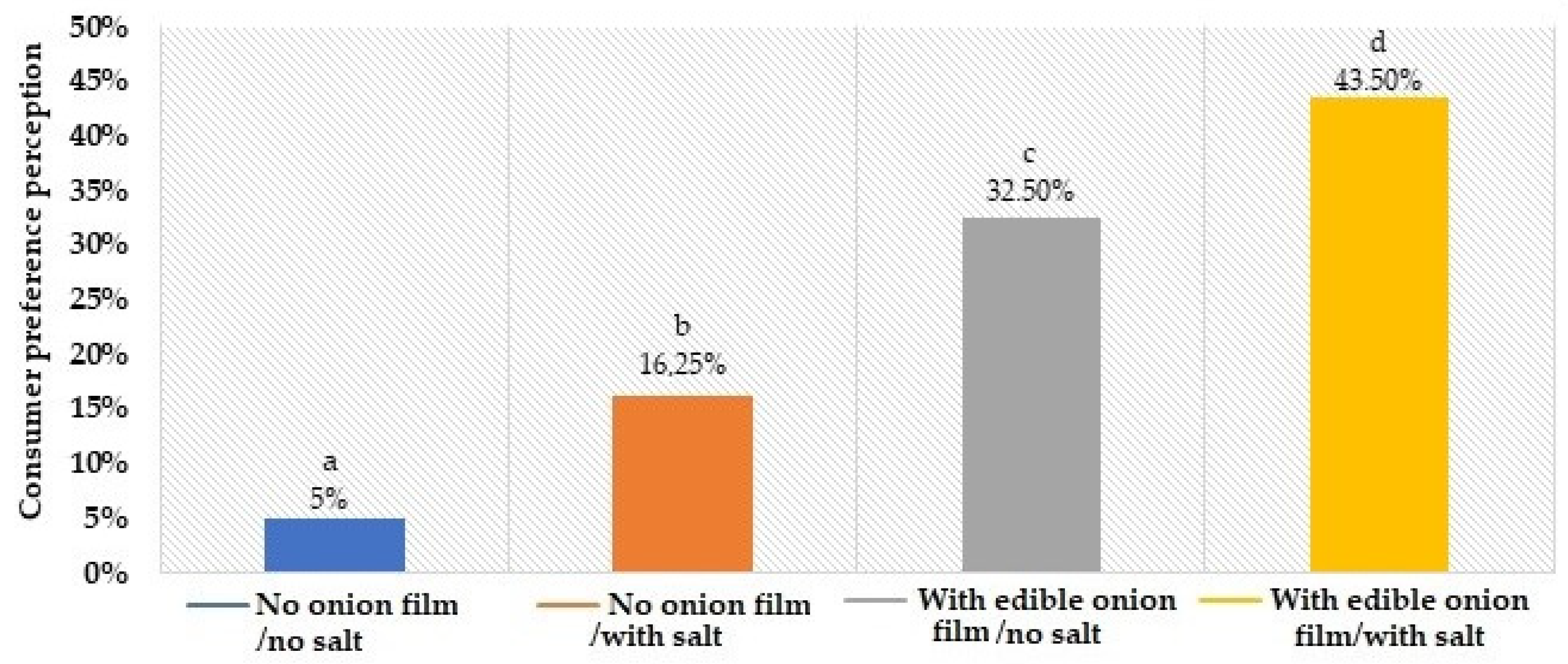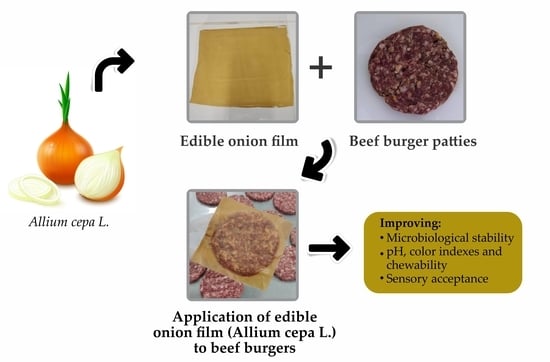Effect of Edible Onion (Allium cepa L.) Film on Quality, Sensory Properties and Shelf Life of Beef Burger Patties
Abstract
:1. Introduction
2. Results
3. Discussion
4. Materials and Methods
4.1. Ethical Considerations and Design Experimental
4.2. Obtaining, Handling and Applying Onion-Based Film
4.3. Beef Burger Patties Preparation
4.4. Physicochemical Analyses
4.5. Lipid Oxidation of Beef Burger Patties
4.6. Microbiological Analysis of Beef Burger Patties
4.7. Sensory Attributes
4.8. Statistical Analysis
5. Conclusions
Author Contributions
Funding
Institutional Review Board Statement
Informed Consent Statement
Data Availability Statement
Acknowledgments
Conflicts of Interest
Sample Availability
References
- Felderhoff, C.; Lyford, C.; Malaga, J.; Polkinghorne, R.; Brooks, C.; Garmyn, A.; Miller, M. Beef Quality Preferences: Factors Driving Consumer Satisfaction. Foods 2020, 9, 289. [Google Scholar] [CrossRef] [PubMed] [Green Version]
- Aboah, J.; Lees, N. Consumers use of quality cues for meat purchase: Research trends and future pathways. Meat Sci. 2020, 166, 108142. [Google Scholar] [CrossRef] [PubMed]
- Ziomek, M.; Drozd, Ł.; Gondek, M.; Pyz-Łukasik, R.; Pedonese, F.; Florek, M.; Domaradzki, P.; Skałecki, P. Microbiological Changes in Meat and Minced Meat from Beavers (Castor fiber L.) during Refrigerated and Frozen Storage. Foods 2021, 10, 1270. [Google Scholar] [CrossRef]
- Kumar, Y.; Yadav, D.N.; Ahmad, T.; Narsaiah, K. Recent Trends in the Use of Natural Antioxidants for Meat and Meat Products. Compr. Rev. Food Sci. Food Saf. 2015, 14, 796–812. [Google Scholar] [CrossRef] [Green Version]
- Vasconcelos, L.; de Souza, M.; de Oliveira, J.; Silva Filho, E.; Silva, A.; Mazzetto, S.E.; Pereira, E.S.; Oliveira, R.L.; Bezerra, L. Elaboration and Characterization of Bioactive Films Obtained from the Incorporation of Cashew Nut Shell Liquid into a Matrix of Sodium Alginate. Antioxidants 2021, 10, 1378. [Google Scholar] [CrossRef] [PubMed]
- Otoni, C.G.; Avena-Bustillos, R.J.; Azeredo, H.; Lorevice, M.V.; Moura, M.R.; Mattoso, L.H.C.; McHugh, T.H. Recent Advances on Edible Films Based on Fruits and Vegetables-A Review. Compr. Rev. Food Sci. Food Saf. 2017, 16, 1151–1169. [Google Scholar] [CrossRef] [Green Version]
- Silva, M.L.T.; Brinques, G.B.; Gurak, P.D. Development and characterization of corn starch bioplastics containing dry sprout by-product flour. Braz. J. Food Technol. 2020, 23, 23. [Google Scholar] [CrossRef]
- FDA. Code of Federal Regulations Title 21—Food for Human Consumption; FDA: Rockville, MD, USA, 2015. [Google Scholar]
- Ruiz-Navajas, Y.; Viuda-Martos, M.; Sendra, E.; Pérez-Alvarez, J.A.; Fernandez-Lopez, J. In vitro antibacterial and antioxidant properties of chitosan edible films incorporated with Thymus moroderi or Thymus piperella essential oils. Food Control 2013, 30, 386–392. [Google Scholar] [CrossRef]
- dos Santos, B.M.M.; Pizato, S.; Cortez-Vega, W.R. Natural edible films and coatings applied in food: a bibliographic review. Res. Soc. Dev. 2020, 9, e578997613. [Google Scholar] [CrossRef]
- Galus, S.; Arik Kibar, E.A.; Gniewosz, M.; Kraśniewska, K. Novel Materials in the Preparation of Edible Films and Coatings—A Review. Coatings 2020, 10, 674. [Google Scholar] [CrossRef]
- Otoni, C.G.; Lodi, B.D.; Lorevice, M.V.; Leitão, R.C.; Ferreira, M.D.; de Moura, M.R.; Mattoso, L.H. Optimized and scaled-up production of cellulose-reinforced biodegradable composite films made up of carrot processing waste. Ind. Crops Prod. 2018, 121, 66–72. [Google Scholar] [CrossRef] [Green Version]
- Ren, F.; Reilly, K.; Kerry, J.P.; Gaffney, M.; Hossain, M.; Rai, D.K. Higher Antioxidant Activity, Total Flavonols, and Specific Quercetin Glucosides in Two Different Onion (Allium cepa L.) Varieties Grown under Organic Production: Results from a 6-Year Field Study. J. Agric. Food Chem. 2017, 65, 5122–5132. [Google Scholar] [CrossRef] [PubMed] [Green Version]
- Slimestad, R.; Fossen, T.; Vågen, I.M. Onions: A Source of Unique Dietary Flavonoids. J. Agric. Food Chem. 2007, 55, 10067–10080. [Google Scholar] [CrossRef] [PubMed]
- Murayyan, A.I.; Manohar, C.M.; Hayward, G.; Neethirajan, S. Antiproliferative activity of Ontario grown onions against colorectal adenocarcinoma cells. Food Res. Int. 2017, 96, 12–18. [Google Scholar] [CrossRef]
- Dias, D.D.S.; Otoni, C.G.; da Silva, R.R.; Meneguin, A.B.; Mattoso, L.H.C.; Barud, H.D.S.; Ribeiro, C.A. Large scale manufacturing of puree-only edible films from onion bulb (Allium cepa L.): Probing production and structure–processing–property correlations. Ind. Crops Prod. 2020, 145, 111847. [Google Scholar] [CrossRef]
- Barreto, M.R.; Aleixo, N.A.; Silvestre, R.B.; Fregonezi, N.F.; Barud, H.D.S.; Dias, D.D.S.; Ribeiro, C.A.; Resende, F.A. Genotoxicological safety assessment of puree-only edible films from onion bulb (Allium cepa L.) for use in food packaging-related applications. J. Food Sci. 2019, 85, 201–208. [Google Scholar] [CrossRef] [PubMed]
- Ramos, L.; Bezerra, L.; de Oliveira, J.; de Souza, M.; da Silva, A.; Pereira, E.; Mazzetto, S.; Filho, J.P.; Oliveira, R. Effects of feeding growing-finishing lambs with cashew nut shell liquid on the growth performance, physicochemical attributes, lipid peroxidation and sensorial parameters of burger. Small Rumin. Res. 2021, 202, 106468. [Google Scholar] [CrossRef]
- Mancini, R.A.; Hunt, M.C. Current research in meat color. Meat Sci. 2005, 71, 100–121. [Google Scholar] [CrossRef]
- Vital, A.C.; Guerrero, A.; Monteschio, J.; Valero, M.V.; Carvalho, C.B.; de Abreu Filho, B.A.; Madrona, G.S.; Prado, I.N.D. Effect of Edible and Active Coating (with Rosemary and Oregano Essential Oils) on Beef Characteristics and Consumer Acceptability. PLoS ONE 2016, 11, e0160535. [Google Scholar] [CrossRef] [Green Version]
- Cardoso, G.P.; Dutra, M.P.; Fontes, P.R.; de Lemos Souza Ramos, A.; de Miranda Gomide, L.A.; Ramos, E.M. Selection of a chitosan gelatin-based edible coating for color preservation of beef in retail display. Meat Sci. 2016, 114, 85–94. [Google Scholar] [CrossRef]
- Insausti, K.; Beriain, M.; Purroy, A.; Alberti, P.; Lizaso, L.; Hernandez, B. Colour stability of beef from different Spanish native cattle breeds stored under vacuum and modified atmosphere. Meat Sci. 1999, 53, 241–249. [Google Scholar] [CrossRef]
- Kaewprachu, P.; Osako, K.; Benjakul, S.; Suthiluk, P.; Rawdkuen, S. Shelf life extension for Bluefin tuna slices (Thunnus thynnus) wrapped with myofibrillar protein film incorporated with catechin-Kradon extract. Food Control 2017, 79, 333–343. [Google Scholar] [CrossRef]
- Faustman, C.; Sun, Q.; Mancini, R.; Suman, S.P. Myoglobin and lipid oxidation interactions: Mechanistic bases and control. Meat Sci. 2010, 86, 86–94. [Google Scholar] [CrossRef] [PubMed]
- Lanzotti, V. A análise da cebola e do alho. J. Chromatogr. A 2006, 1112, 3–22. [Google Scholar] [CrossRef] [Green Version]
- Sidhu, J.S.; Ali, M.; Al-Rashdan, A.; Ahmed, N. Cebola (Allium cepa L.) é potencialmente um boa fonte de antioxidantes importantes. J. Food Sci. Technol. 2019, 56, 1811–1819. [Google Scholar] [CrossRef]
- Rodriguez, G.B.; Rodriguez Rodriguez, E.M.; Romero, C.D. Flavonóides em cultivares de cebola (Allium cepa L.). J. Food Sci. 2008, 73, 599–605. [Google Scholar] [CrossRef]
- Rietjens, I.M.; Boersma, M.G.; Van Der Woude, H.; Jeurissen, S.M.; Schutte, M.E.; Alink, G.M. Flavonóides e alquenilbenzenos: Mecanismos de ação mutagênica e risco cancerígeno. Mutat. Res. 2005, 574, 124–138. [Google Scholar] [CrossRef]
- Raeisi, M.; Tajik, H.; Aliakbarlu, J.; Mirhosseini, S.H.; Hosseini, S.M.H. Effect of carboxymethyl cellulose-based coatings incorporated with Zataria multiflora Boiss. essential oil and grape seed extract on the shelf life of rainbow trout fillets. LWT Food Sci. Technol. 2015, 64, 898–904. [Google Scholar] [CrossRef]
- Moghtadaei, M.; Soltanizadeh, N.; Goli, S.A.H. Production of sesame oil oleogels based on beeswax and application as partial substitutes of animal fat in beef burger. Food Res. Int. 2018, 108, 368–377. [Google Scholar] [CrossRef]
- Behbahani, B.A.; Imani, A.A.F. Development of a novel edible coating made by Balangu seed mucilage and Feverfew essential oil and investigation of its effect on the shelf life of beef slices during refrigerated storage through intelligent modeling. J. Food Saf. 2018, 38, 12443. [Google Scholar] [CrossRef]
- Ghani, S.; Barzegar, H.; Noshad, M.; Hojjati, M. The preparation, characterization and in vitro application evaluation of soluble soybean polysaccharide films incorporated with cinnamon essential oil nanoemulsions. Int. J. Biol. Macromol. 2018, 112, 197–202. [Google Scholar] [CrossRef]
- Behbahani, B.A.; Shahidi, F.; Yazdi, F.T.; Mortazavi, S.A.; Mohebbi, M. Use of Plantago major seed mucilage as a novel edible coating incorporated with Anethum graveolens essential oil on shelf life extension of beef in refrigerated storage. Int. J. Biol. Macromol. 2017, 94, 515–526. [Google Scholar] [CrossRef] [PubMed]
- de Gouvêa, A.A.; Oliveira, R.L.; Leão, A.G.; Assis, D.Y.; Bezerra, L.R.; Júnior, N.G.N.; Trajano, J.S.; Pereira, E.S. Color, sensory and physicochemical attributes of beef burger made using meat from young bulls fed levels of licuri cake. J. Sci. Food Agric. 2016, 96, 3668–3672. [Google Scholar] [CrossRef] [PubMed]
- Rezaei, M.; Hosseini, S. Quality assessment of farmed rainbow trout (Oncorhynchus mykiss) during chilled storage. J. Food Sci. 2008, 73, H93–H96. [Google Scholar] [CrossRef] [PubMed]
- Johns, A.; Birkinshaw, L.; Ledward, D. Catalysts of lipid oxidation in meat products. Meat Sci. 1989, 25, 209–220. [Google Scholar] [CrossRef]
- Saini, R.K.; Prasad, P.; Sreedhar, R.V.; Akhilender Naidu, K.; Shang, X.; Keum, Y.-S. Omega−3 Polyunsaturated Fatty Acids (PUFAs): Emerging Plant and Microbial Sources, Oxidative Stability, Bioavailability, and Health Benefits—A Review. Antioxidants 2021, 10, 1627. [Google Scholar] [CrossRef] [PubMed]
- Alexandre, A.C.S.; Albergaria, F.C.; Silva, L.M.S.F.; Fernandes, L.A.C.; Gomes, M.E.d.S.; Pimenta, C.J. Effect of natural and synthetic antioxidants on oxidation and storage stability of mechanically separated tilapia meat. LWT 2021, 154, 112679. [Google Scholar] [CrossRef]
- Alghazeer, R.; Saeed, S.; Howell, N.K. Aldehyde formation in frozen mackerel (Scomber scombrus) in the presence and absence of instant green tea. Food Chem. 2008, 108, 801–810. [Google Scholar] [CrossRef] [Green Version]
- İnanç, T.; Maskan, M. Effect of cinnamaldehyde on oxidative stability of several fats and oils at elevated temperatures. Cogent Food Agr. 2015, 1, 1071725. [Google Scholar] [CrossRef]
- Sharma, R.; Ghoshal, G. Emerging trends in food packaging. Nutr. Food Sci. 2018, 48, 764–779. [Google Scholar] [CrossRef]
- Ahiabor, C.; Gordon, A.; Ayittey, K.; Agyare, R. In vitro assessment of antibacterial activity of crude extracts of onion (Allium cepa L.) and shallot (Allium aescalonicum L.) on isolates of Escherichia coli (ATCC 25922), Staphylococcus aureus (ATCC 25923), and Salmonella typhi (ATCC 19430). Int. J. Appl. Res. 2016, 2, 1029–1032. [Google Scholar]
- Guo, M.; Yadav, M.P.; Jin, T.Z. Antimicrobial edible coatings and films from micro-emulsions and their food applications. Int. J. Food Microbiol. 2017, 263, 9–16. [Google Scholar] [CrossRef] [PubMed]
- Burt, S. Essential oils: Their antibacterial properties and potential applications in foods—a review. Int. J. Food Microbiol. 2004, 94, 223–253. [Google Scholar] [CrossRef] [PubMed]
- Kester, J.J.; Fennema, O.R. Edible Films and Coatings: A Review. Food Technol. 1986, 40, 47–59. [Google Scholar]
- Jones, M.G.; Hughes, J.; Tregova, A.; Milne, J.; Tomsett, A.B.; Collin, H.A. Biosynthesis of the flavour precursors of onion and garlic. J. Exp. Bot. 2004, 55, 1903–1918. [Google Scholar] [CrossRef] [Green Version]
- Rose, P.; Whiteman, M.; Moore, P.K.; Zhu, Y.Z. Bioactive S-alk(en)yl cysteine sulfoxide metabolites in the genus Allium: The chemistry of potential therapeutic agents. Nat. Prod. Rep. 2005, 22, 351–368. [Google Scholar] [CrossRef] [PubMed]
- Liguori, L.; Califano, R.; Albanese, D.; Raimo, F.; Crescitelli, A.; Di Matteo, M. Chemical Composition and Antioxidant Properties of Five White Onion (Allium cepa L.) Landraces. J. Food Qual. 2017, 2017, 6873651. [Google Scholar] [CrossRef] [Green Version]
- Miltenburg, G.A.J.; Wensing, T.; Smulders, F.J.M.; Breukink, H.J. Relationship between blood hemoglobin, plasma and tissue iron, muscle heme pigment, and carcass color of veal1. J. Anim. Sci. 1992, 70, 2766–2772. [Google Scholar] [CrossRef]
- Hunt, M.C.; King, A. Meat Color Measurement Guidelines; American Meat Science Association: Champaign, IL, USA, 2012. [Google Scholar]
- AMSA. Research Guidelines for Cookery, Sensory Evaluation and Instrumental Tenderness Measurements of Fresh Meat; National Livestock and Meat Board: Chicago, IL, USA, 1995. [Google Scholar]
- Bourne, M.C. Texture Profile Analysis. Food Nutr. Sci. 1978, 6, 62–67. [Google Scholar]
- Jridi, M.; Mora, L.; Souissi, N.; Aristoy, M.-C.; Nasri, M.; Toldrá, F. Effects of active gelatin coated with henna (L. inermis) extract on beef meat quality during chilled storage. Food Control 2018, 84, 238–245. [Google Scholar] [CrossRef]
- Witte, V.C.; Krause, G.F.; Bailey, M.E. A new extraction method for determining 2-thiobarbituric acid values of pork and beef during storage. J. Food Sci. 1970, 35, 582–585. [Google Scholar] [CrossRef]
- Silva, N.S.; Junquira, V.C.; Silveira, N.F.; Taniwaki, M.H.; Santos, R.F.; Gomes, R.A.; Okazaki, M.M. Manual de Métodos de Análise Microbiológica de Alimentos, 3rd ed.; Logomarca Varela: São Paulo, Brazil, 2007. [Google Scholar]



| Variables | Treatment | Storage Times (Days) | |||
|---|---|---|---|---|---|
| 0 Days | 3 Days | 6 Days | 9 Days | ||
| Luminosity (L*) | Control | 44.22 ± 0.59 Aa | 43.02 ± 0.75 Ba | 42.35 ± 0.44 BCa | 41.24 ± 1.02 Ca |
| Edible onion film | 42.97 ± 0,29 Ab | 40.83 ± 1.42 BCb | 42.18 ± 0.80 ABa | 39.81 ± 0.72 Cb | |
| Redness (a*) | Control | 14.38 ± 0.84 Ab | 11.58 ± 0.87 Bb | 9.71 ± 0.59 Cb | 6.00 ± 0.25 Db |
| Edible onion film | 16.02 ± 0.86 Aa | 14.42 ± 0.73 Ba | 14.42 ± 1.10 Ba | 13.03 ± 0.77 Ba | |
| Yellowness (b*) | Control | 7.35 ± 0.25 Ab | 7.13 ± 1.05 Aa | 5.04 ± 0.47 Bb | 3.77 ± 0.79 Cb |
| Edible onion film | 9.39 ± 0.40 Aa | 8.44 ± 0.82 Bb | 7.99 ± 0.25 Ba | 8.75 ± 0.35 ABa | |
| Chrome (C*) | Control | 16.16 ± 0.72 Ab | 13.62 ± 1.11 Bb | 10.95 ± 0.66 Cb | 7.13 ± 0.25 Db |
| Edible onion film | 18.53 ± 0.91 Aa | 16.72 ± 0.91 Ba | 16.49 ± 0.98 Ba | 15.69 ± 0.82 Ba | |
| Variables | Treatment | Storage Times (Days) | |||
|---|---|---|---|---|---|
| 0 Days | 3 Days | 6 Days | 9 Days | ||
| pH | Control | 5.68 ± 0.39 aB | 6.11 ± 0.10 aAB | 6.19 ± 0.04 aA | 5.20 ± 0.11 aC |
| Edible onion film | 5.79 ± 0.07 aA | 5.59 ± 0.05 bB | 5.41 ± 0.04 bC | 4.40 ± 0.06 bD | |
| WHC 1 (%) | Control | 27.43 ± 0.85 aA | 22.03 ± 2.20 aB | 22.43 ± 1.53 aB | 16.05 ± 0.66 aC |
| Edible onion film | 20.06 ± 2.84 bAB | 17.75 ± 2.85 aAB | 23.31 ± 1.84 aA | 16.01 ± 2.41 aB | |
| Cooking loss (%) | Control | 21.60 ± 3.64 aB | 15.94 ± 2.38 aB | 19.70 ± 1.99 aB | 23.73 ± 3.36 aA |
| Edible onion film | 16.28 ± 3.94 aB | 16.75 ± 2.03 aB | 17.86 ± 1.93 aB | 26.97 ± 0.27 aA | |
| Iron content (μg/g) | Control | 20.75 ± 1.58 aA | 16.85 ± 0.86 aB | 15.29 ± 1.78 aB | 14.27 ± 0.72 aB |
| Edible onion film | 18.79 ± 0.30 aA | 18.17 ± 1.02 aA | 16.21 ± 1.66 aB | 14.09 ± 0.76 aB | |
| Lipid oxidation 2 | Control | 0.78 ± 0.06 aC | 1.10 ± 0.12 aC | 1.72 ± 0.10 aB | 2.12 ± 0.23 aA |
| Edible onion film | 0.80 ± 0.07 aC | 1.07 ± 0.01 aC | 1.67 ± 0.19 aB | 2.23 ± 0.20 aA | |
| Texture Parameter | Treatment | Storage Times (Days) | |||
|---|---|---|---|---|---|
| 0 Days | 3 Days | 6 Days | 9 Days | ||
| Hardness (N) | Control | 17.35 ± 3.54 aB | 15.83 ± 4.27 aB | 14.87 ± 2.56 aB | 20.09 ± 3.40 aA |
| Edible onion film | 16.26 ± 2.90 aB | 23.97 ± 6.13 aA | 15.15 ± 3.90 aB | 20.27 ± 1.92 aA | |
| Springiness | Control | 0.75 ± 0.09 aA | 0.85 ± 0.01 aB | 0.85 ± 0.05 aB | 0.89 ± 0.02 aB |
| Edible onion film | 0.86 ± 0.01 aA | 0.83 ± 0.10 aA | 0.81 ± 0.02 aA | 0.85 ± 0.01 bA | |
| Chewability (N) | Control | 850.02 ± 92.21 aB | 590.96 ± 5 0.79 bC | 689.07 ± 61.84 aC | 1060.51 ± 75.85 aA |
| Edible onion film | 688.41 ± 42.89 bB | 965.95 ± 87.28 aA | 693.96 ± 38.87 aB | 762.48 ± 71.00 bB | |
| Cohesiveness | Control | 0.50 ± 0.05 aA | 0.42 ± 0.05 aA | 0.45 ± 0.07 aA | 0.51 ± 0.05 aA |
| Edible onion film | 0.50 ± 0.03 aA | 0.46 ± 0.05 aB | 0.39 ± 0.07 aB | 0.44 ± 0.05 aA | |
Publisher’s Note: MDPI stays neutral with regard to jurisdictional claims in published maps and institutional affiliations. |
© 2021 by the authors. Licensee MDPI, Basel, Switzerland. This article is an open access article distributed under the terms and conditions of the Creative Commons Attribution (CC BY) license (https://creativecommons.org/licenses/by/4.0/).
Share and Cite
Soares, K.S.; Souza, M.P.; Silva-Filho, E.C.; Barud, H.S.; Ribeiro, C.A.; Santos, D.D.; Rocha, K.N.S.; de Moura, J.F.P.; Oliveira, R.L.; Bezerra, L.R. Effect of Edible Onion (Allium cepa L.) Film on Quality, Sensory Properties and Shelf Life of Beef Burger Patties. Molecules 2021, 26, 7202. https://doi.org/10.3390/molecules26237202
Soares KS, Souza MP, Silva-Filho EC, Barud HS, Ribeiro CA, Santos DD, Rocha KNS, de Moura JFP, Oliveira RL, Bezerra LR. Effect of Edible Onion (Allium cepa L.) Film on Quality, Sensory Properties and Shelf Life of Beef Burger Patties. Molecules. 2021; 26(23):7202. https://doi.org/10.3390/molecules26237202
Chicago/Turabian StyleSoares, Kallyne Sousa, Marthyna Pessoa Souza, Edson C. Silva-Filho, Hernane Silva Barud, Clóvis Augusto Ribeiro, Diógenes Dias Santos, Karla Nayalle Souza Rocha, José Fabio Paulino de Moura, Ronaldo Lopes Oliveira, and Leilson Rocha Bezerra. 2021. "Effect of Edible Onion (Allium cepa L.) Film on Quality, Sensory Properties and Shelf Life of Beef Burger Patties" Molecules 26, no. 23: 7202. https://doi.org/10.3390/molecules26237202
APA StyleSoares, K. S., Souza, M. P., Silva-Filho, E. C., Barud, H. S., Ribeiro, C. A., Santos, D. D., Rocha, K. N. S., de Moura, J. F. P., Oliveira, R. L., & Bezerra, L. R. (2021). Effect of Edible Onion (Allium cepa L.) Film on Quality, Sensory Properties and Shelf Life of Beef Burger Patties. Molecules, 26(23), 7202. https://doi.org/10.3390/molecules26237202










